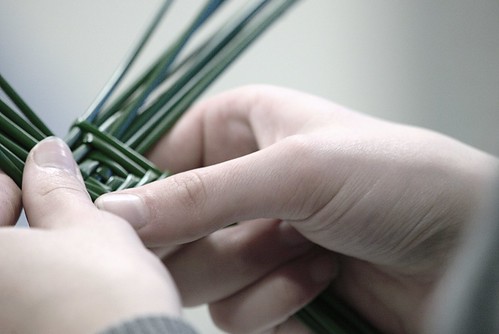Today is the 1st of February which is the feast day of St Brigit in the roman church. Many see the correlation to the more original tale of Brigit in Celtic traditions which have been around long before the Roman Church became Christianized.
St Brigit is seen now as a patron saint of Ireland but what were her origins before the Roman Church doctored the history to make it read the way they wished it to be seen. This fabrication has created a disconnection in the people with their divine nature and their way of keeping in good with it all.
Today on St Brigit's day crosses are woven in her name but they really point to a past when sun worship was the order of the day and a pagan origin, at that time Rome also worshiped the sun with the Mithra.
"Brigid's cross or Brigit's cross (Irish: Cros Bríde, Crosóg Bríde or Bogha Bríde) is a small cross usually woven from rushes. Typically it has four arms tied at the ends and a woven square in the middle. Historically, there were also three-armed versions. It is suggested that the cross has pre-Christian origins and is related to the sun cross.
Brigid's crosses are associated with Brigid of Kildare, one of the patron saints of Ireland. The crosses are traditionally made in Ireland on St Brigid's feast day, 1 February, which was formerly celebrated as a pagan festival (Imbolc) marking the beginning of spring. Many rituals are associated with the making of the crosses. Traditionally they were set over doorways and windows to protect the home from any kind of harm." From Wiki
In Celtic polytheism and Irish mythology, Brigit, Brigid or Brighid (exalted one) is the daughter of the Dagda and one of the Tuatha Dé Danann. She was the wife of Bres of the Fomorians, with whom she had a son, Ruadán.
As is often the case with Celtic deities who are described as threefold, she is seen as three sisters, all named Brigid, who perform various functions in society, such as healing, poetry and smithcraft.
The Dagda was a High King of the Tuatha Dé Danann after his predecessor Nuada was injured in battle. The Tuatha Dé Danann are the race of supernatural beings who conquered the Fomorians, who inhabited Ireland previously, prior to the coming of the Milesians
The Tuatha Dé Danann are a supernatural race in Irish mythology. The Tuath Dé dwell in the Otherworld but interact with humans and the human world. Their traditional rivals are the Fomorians (Fomoire), who seem to represent the harmful or destructive powers of nature.
The Formorians are a supernatural race in Irish mythology.
Imbolc has been associated with the goddess "Brigit" - a Celtic fire goddess. Imbolc celebrations often include large bonfires, or large quantities of candles light throughout the home. Meals served on this day are often heavy with cream.
 |
| Source: Flickr |
Brigid is the fire-keeper of that flame of life that mothers tend to so that we don't die in the winter, and so the lines of family are not broken by the trauma of the cold months. In the winter, Brighid becomes the cailleach, the woman in agedness, and on Imbolc she collected the kindling of the fires that get her to the spring of regeneration.
Christian interpretation in Ireland makes Brigid into a nun, and children occupy themselves by taking bits of straw and weaving this potential-kindling into the shape of spiraling Brigid's crosses.
St. Brigid is said to have invented the cross herself while attending a sickbed and picking up rushes from the floor to craft them into a sacred cross.
Taking up the tradition in its many forms focuses the mind in the meditation of craft, and connects our winter minds mad at the cold to the great wheel that turns and is slowly bringing us into the spring of renewal.

1 comment:
Did you know you can create short links with AdFocus and make money for every visit to your shortened links.
Post a Comment